Continued from Part One
The neatly arrayed trees lining the road that we used to enter Pripyat stood in stark contrast to the haphazard growth that had begun reclaiming the nearby buildings. What looked to have once been a convenience store was presently no more than a pile of rubble, and what could have been a mechanic’s garage in another era now resembled something like a mad botanist’s greenhouse, with an assortment of various plants sprouting from every crevice and a stunted tree doing its best to break through the concrete and metal that had been left behind.
The crumbling structures and unchecked growth did not come as a surprise. These were the reasons we were here, in one of the world’s most infamous ghost towns. Pripyat is most certainly a ghost town in the traditional sense of being full of abandoned buildings and left to nature’s devices, but in a second sense as well – this place is haunted by the tragedy that spurred its abandonment nearly three decades prior, when the explosion at the Chernobyl Nuclear Power Plant caused massive radioactive fallout and claimed thousands of victims, continuing to affect survivors and their families to this day.
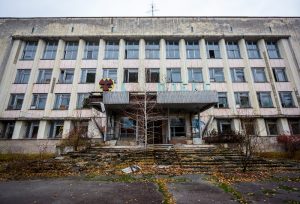 As we disembarked, our large group scattered, snapping pictures and heading to whichever abandoned structure lining the central square caught their eyes. The desolation of the place was striking. Massive apartment towers, hotels, and commercial complexes loomed over us, their windows gone, decay setting in, but their sturdy Soviet style construction showing no signs of wavering in the face of nature’s aggression. Yet there was a strange beauty to the large square that had once served as the central promenade in the Soviet Union’s flagship nuclear city. It wasn’t just the remnants of careful planning left over from Pripyat’s heyday, but rather a unique interplay between the vestiges of a thriving city and the reclamation of the area by the local flora.
As we disembarked, our large group scattered, snapping pictures and heading to whichever abandoned structure lining the central square caught their eyes. The desolation of the place was striking. Massive apartment towers, hotels, and commercial complexes loomed over us, their windows gone, decay setting in, but their sturdy Soviet style construction showing no signs of wavering in the face of nature’s aggression. Yet there was a strange beauty to the large square that had once served as the central promenade in the Soviet Union’s flagship nuclear city. It wasn’t just the remnants of careful planning left over from Pripyat’s heyday, but rather a unique interplay between the vestiges of a thriving city and the reclamation of the area by the local flora.
We set off through the square and made our way past what must have been bustling enterprises before the sudden evacuation so many years ago. The supermarket, the theatre, the amusement park – the pace we were setting was quick, and taking thoughtful photos while still having time to explore much past the facades of these ruined buildings was proving difficult – not that one could really venture too deep without considerable risk. Most of us were travelling light, and with rotting floors, collapsed crossbeams, and windows that were mostly boarded up, we just weren’t equipped to explore most of the interiors fully. And that’s not to mention that one of these dark, warm derelicts would have been a perfect den for the bears and wolves that, according to our guide, had begun calling Pripyat home in recent years.
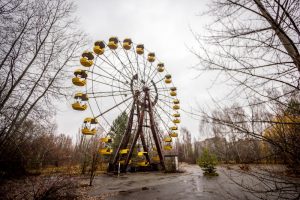 The amusement park, which was mere days away from opening when the city was evacuated, was just as desolate and depressing as we had hoped. We lined up to snap photos of the rusted out bumper cars, the collapsed swings, and of course the most prominent landmark of the city, the Ferris wheel. But we had seen these things before, in photo series, articles, and even the documentary we watched on the bus ride to our destination. Of course being there in person is different, but we wanted to seek out the hidden secrets and dark corners, the places we would never be able to experience outside of this trip. And we were not to be disappointed.
The amusement park, which was mere days away from opening when the city was evacuated, was just as desolate and depressing as we had hoped. We lined up to snap photos of the rusted out bumper cars, the collapsed swings, and of course the most prominent landmark of the city, the Ferris wheel. But we had seen these things before, in photo series, articles, and even the documentary we watched on the bus ride to our destination. Of course being there in person is different, but we wanted to seek out the hidden secrets and dark corners, the places we would never be able to experience outside of this trip. And we were not to be disappointed.
The next stop, the stadium, was shockingly well preserved. The rows upon rows of wooden benches looked like they could have still comfortably fit a crowd of 1,000 had the playing field they were meant to overlook not become a thick forest over the last thirty years. Inside, however, things were as barren as could be. The paint had long since disappeared, lights and fixtures were gone, wires hung from open ceilings and shattered window panes littered the floors and staircases. There was little of interest in this concrete bunker, until one of my compatriots beckoned to me. He had found an entrance to the basement.
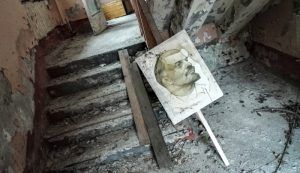 We slowly walked through the pitch black hallways, trying our best to illuminate the way with what little light was available. Every time I triggered the flash on my camera I expected to see a feral animal crouched in a corner or something even more frightening, though I wasn’t quite sure what it would be. But the flash revealed only rotting wood, rusting scrap metal, standing water, and an unbelievable amount of dust in the air. Considering the conditions, that dust was probably composed mostly of radioactive mold spores and asbestos insulation, so we quietly retreated, disappointed in our basement venture. By the time we emerged, our guide had clearly grown tired of having to corral the members of our group and simply left us behind. Being that Pripyat is a rather large place – it was just a few hundred shy of 50,000 people in its last days – we were fortunate to stumble across a few others from our group after wandering aimlessly for a short while. Apparently, we had an hour left to explore one of the schools and the public swimming pool, and then we were out of there. We ran.
We slowly walked through the pitch black hallways, trying our best to illuminate the way with what little light was available. Every time I triggered the flash on my camera I expected to see a feral animal crouched in a corner or something even more frightening, though I wasn’t quite sure what it would be. But the flash revealed only rotting wood, rusting scrap metal, standing water, and an unbelievable amount of dust in the air. Considering the conditions, that dust was probably composed mostly of radioactive mold spores and asbestos insulation, so we quietly retreated, disappointed in our basement venture. By the time we emerged, our guide had clearly grown tired of having to corral the members of our group and simply left us behind. Being that Pripyat is a rather large place – it was just a few hundred shy of 50,000 people in its last days – we were fortunate to stumble across a few others from our group after wandering aimlessly for a short while. Apparently, we had an hour left to explore one of the schools and the public swimming pool, and then we were out of there. We ran.
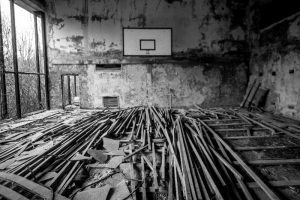 The school was huge and relatively untouched by looters and graffiti artists, but was generally full of the expected. Peeling murals, books strewn across the floors of desolate classrooms, a darkened gymnasium succumbing to the elements, thousands of gas masks scattered across the floor of the cafeteria, with some suspended from meat hooks – OK, not everything was as expected. When we moved on to the building that had been called the “swimming pool,” we found it to be more of a labyrinthine series of tiny rooms and giant gymnasiums with obstacles and hidden dangers scattered throughout. This was definitely the least stable structure we had been in yet. Practically the entire facade of the building had collapsed, leaving large portions of the building open to the elements. This had increased the amount of weathering, obviously, along with the amount of standing water, leaking ceilings, and rotting floors. Eventually we made it to the pool, and as I was lining up the perfect shot of this graffiti covered concrete hole, I heard my name being called.
The school was huge and relatively untouched by looters and graffiti artists, but was generally full of the expected. Peeling murals, books strewn across the floors of desolate classrooms, a darkened gymnasium succumbing to the elements, thousands of gas masks scattered across the floor of the cafeteria, with some suspended from meat hooks – OK, not everything was as expected. When we moved on to the building that had been called the “swimming pool,” we found it to be more of a labyrinthine series of tiny rooms and giant gymnasiums with obstacles and hidden dangers scattered throughout. This was definitely the least stable structure we had been in yet. Practically the entire facade of the building had collapsed, leaving large portions of the building open to the elements. This had increased the amount of weathering, obviously, along with the amount of standing water, leaking ceilings, and rotting floors. Eventually we made it to the pool, and as I was lining up the perfect shot of this graffiti covered concrete hole, I heard my name being called.
It felt strange to hear my name echo through such a desolate environment, and I almost thought I had imagined it. But it came again, so I made my way through the debris back to the weed-infested exterior of the building. It was our tour leader calling me, and he informed me that our local guide had given us twenty minutes to go exploring on our own in an old apartment block – a place that was meant to be very much off limits. The reasons these apartment buildings had been made off limits was abundantly clear as I stepped inside. Windows broken, the interiors had been exposed to the elements for a long time, and many of the floorboards were worn through, with mold and even some adventurous plants beginning to take root. We slowly made our way up the stairwells, stopping to peek into housing that had long since been looted of any valuables, but still gave a striking expression of the comfortable if spartan way of life that Pripyat residents had enjoyed before everything went to hell all those years ago.
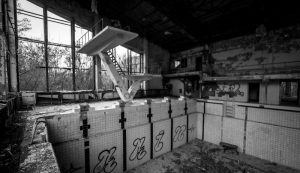 Finally emerging on the rooftop, we were given one last look at the entire expanse of Pripyat, with the entombed nuclear reactor lurking in the distance as a reminder to why this city now stood empty. With so many nooks and crannies left unexplored, Pripyat is truly the urban explorer’s dream come true – and will be for all of the minimum 50,000 years that it will take for this once Utopian dream to completely overcome the effects of nuclear disaster. Unique among ghost towns, Pripyat stands as a unique, horrific reminder of man’s power over his environment – but also serves an example of how resilient nature can be, and how quickly it will move to reclaim any area that we decide is no longer suitable for habitation.
Finally emerging on the rooftop, we were given one last look at the entire expanse of Pripyat, with the entombed nuclear reactor lurking in the distance as a reminder to why this city now stood empty. With so many nooks and crannies left unexplored, Pripyat is truly the urban explorer’s dream come true – and will be for all of the minimum 50,000 years that it will take for this once Utopian dream to completely overcome the effects of nuclear disaster. Unique among ghost towns, Pripyat stands as a unique, horrific reminder of man’s power over his environment – but also serves an example of how resilient nature can be, and how quickly it will move to reclaim any area that we decide is no longer suitable for habitation.





